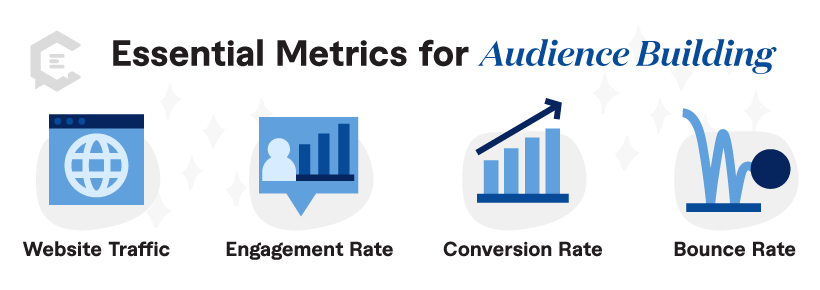Content marketing is all about establishing connections. Every piece of content is an opportunity to engage a potential customer, reinforce your brand, or establish your expertise.
But how do you ensure your content reaches the right audience?
In this guide, we will provide actionable steps to strategically define and expand your audience through content creation. We’ll also cover how to distribute that content and measure its success.

Understanding Your Target Audience
Before creating your content, you must understand who it’s for. Why?
Because without a clear understanding of your target audience, even the most well-crafted content can be ignored. Defining your audience helps you align your content with their needs and interests. That, in turn, leads to better engagement and conversion rates.
Tools and Techniques to Identify Your Audience
Lucky for us, there are a lot of tools available to help you hone in on who you’re targeting.
Analytics
Analytics are your best friend when it comes to finding your target audience. They can shed light on demographics, user behavior, and content preferences. For example, Google Analytics has an “audience tab” covering the basics. Under their “Demographics” tab, you can get information on:
- Location
- Age range
- Gender
- Language
Does it stop there? Nope. They also have an “Interests” tab that provides data on what type of industries they like, where they’re looking, and what they’re buying.
Last but not least, don’t sleep on using AI analytics tools like Qualtrics that can build accurate predictive models on user behavior to forecast future patterns.
Surveys
Surveys are a great way to get direct feedback from current and potential customers. You can get data on everything from buying preferences to pain points. That will allow you to tailor your product or service to speak to those user patterns. Also, regular surveys help you get ahead of any customer trends happening in your industry so you can recalibrate your strategy.
Social listening
Social media is a direct feedback loop for your business. Whereas analytics tracking provides the “what” and “who” of your target audience, social media listening provides the “why.” Through social listening, you can learn:
- Trending topics in your industry
- Where customers are engaging
- Why they’re interacting with certain brands
- What campaigns are succeeding
- Why those campaigns are successful
You can check keyword searches, tags, brand mentions, and DMs across multiple social platforms. Then, you can adjust your content creation to maximize its impact on your target audience.
Developing Buyer Personas
Buyer personas, in a nutshell, are fictional representations of your ideal target customers.
You can use them to personify your customer segment and provide structure and context for your content creation.
Personas in Content Creation
Personas help segment your audience based on varied characteristics. As you build them, ask specific questions to get your personas as detailed as possible. Once you know ‘who’ you’re writing for, you can craft content that speaks directly to them, addresses specific problems, and offers tailored solutions.
Interviews
Interviews are one of the best ways to lay the foundation of your buyer persona, and your existing customer base is a great place to start. Pick customers from each side of the spectrum: those who have had good experiences with your brand and others who haven’t. That will give you a cohesive perspective on how your brand is performing for your target audience. It’ll also reveal valuable insights into customer behaviors, motivations, and pain points.
Crafting High-Quality, Relevant Content
Alright, we’ve pinpointed our target audience and built our buyer personas. Now, it’s time to create the content.
The Importance of Content Relevance and Quality
Just producing loads of content isn’t enough. Your content needs to be high-quality and resonate with your audience to stand out.
Why Relevance Matters
What differentiates successful content from the rest is its alignment with your audience’s needs and the precision with which it’s written. Your content’s relevance increases your success through:
- Creating a Personalized Experience: 66 percent of customers expect companies to understand their unique needs [Forbes]. Relevant content feels tailor-made, creating a deeper experience for them that builds a connection with your brand.
- Driving Engagement: The more relevant the content, the more likely it’ll be consumed and shared. It leads to extended page visits and higher conversions.
- Building Trust: By addressing your audience’s pain points and concerns, you demonstrate your brand’s understanding of their needs. That understanding establishes your authority and starts to foster trust.
The Role of Quality
If your content’s relevance shows your care for an audience’s needs, your quality showcases your commitment to excellence. That excellence has all kinds of benefits, including:
- Showcasing Expertise: High-quality content demonstrates your brand’s credibility and professionalism. That expertise establishes you as a thought leader in your industry that positions you as a company customers can rely on.
- Boosting SEO: Right now, search engines reward relevant, quality content. That means your quality will help you rank higher, increasing your visibility and reach.
Types of Content for Audience Building
As you implement your content creation strategy, consider what type of content your audience prefers. This is where the buyer personas come in handy. If you’re having trouble, check out our list of the “Top 25 Types of Content for Inbound Marketing.” As you create your content, ask yourself:
- Does the content type speak to your buyer personas?
- Does the content type address your buyer’s specific pain point or challenge?
- Does the content type align with your campaign goals?
Also, read Semrush’s 2023 State of Content Marketing Report to get a comprehensive overview of the current content types in marketing. Right now, the top five content types are:
- Video
- Short-form articles
- Long-form blog posts
- Case studies
- Success stories
Answer the three questions above, research content types, and decide which aligns best with your overall content strategy. Keep in mind to diversify your content offerings based on what your audience prefers. Regularly review your content’s performance and be ready to adapt your strategy based on what’s working and what isn’t.
For example, those in the financial industry may attract an audience that varies by age, net worth, and more. With such different buyer personas, it only makes sense that you’d create different financial content types tailored to each segment.
Here’s what that could look like:
- Video: Short videos on retirement planning, tax-saving, or market updates appeal to younger, tech-savvy audiences who may prefer quick, digestible content.
- Short-form articles: Concise blogs about trending financial topics, like changes in interest rates or economic forecasts, attract time-strapped professionals looking for bite-sized updates.
- Long-form blog posts: In-depth content on estate planning, investment strategies, or tax planning will be attractive to business owners looking for expert advice and detailed information.
- Case studies: Case studies can be powerful tools for establishing trust with all potential clients who want real-world examples of your expertise and past successes.
Measuring & Optimizing
Your audience building doesn’t end once you hit publish. In fact, it never really ends. You need to consistently measure your content’s performance and recalibrate it to ensure you keep resonating with your audience’s evolving needs.
Essential Metrics for Audience Building
Here are some specific metrics to monitor:
- Website Traffic: The number of users visiting your site, the pages they visit, and how long they stay.
- Engagement Rate: How your audience interacts with your content, including likes, shares, comments, and more.
- Conversion Rate: The amount of desired action users take with your content. This could be anything from signing up for a newsletter to purchasing.
- Bounce Rate: This is the number of people who visit your website or landing page, do not take action, and leave. We obviously want this number to be low.
It’s essential to monitor these metrics and pivot your strategy (if need be) based on the data. That ensures your content remains relevant and, more importantly, effective at driving engagement and conversions.
Feeling Ready to Master Your Audience Building?
Building an audience through content requires consistent commitment. You need to understand your audience, refine your strategy, and continue to produce high-quality content.
If you’re looking for support in that process, ClearVoice is here to help! Our content creation process and expert team can help you ensure you build the best audience for your brand and create lifelong customers through top-tier content. Talk to a strategist today or discover our solutions to get started.







